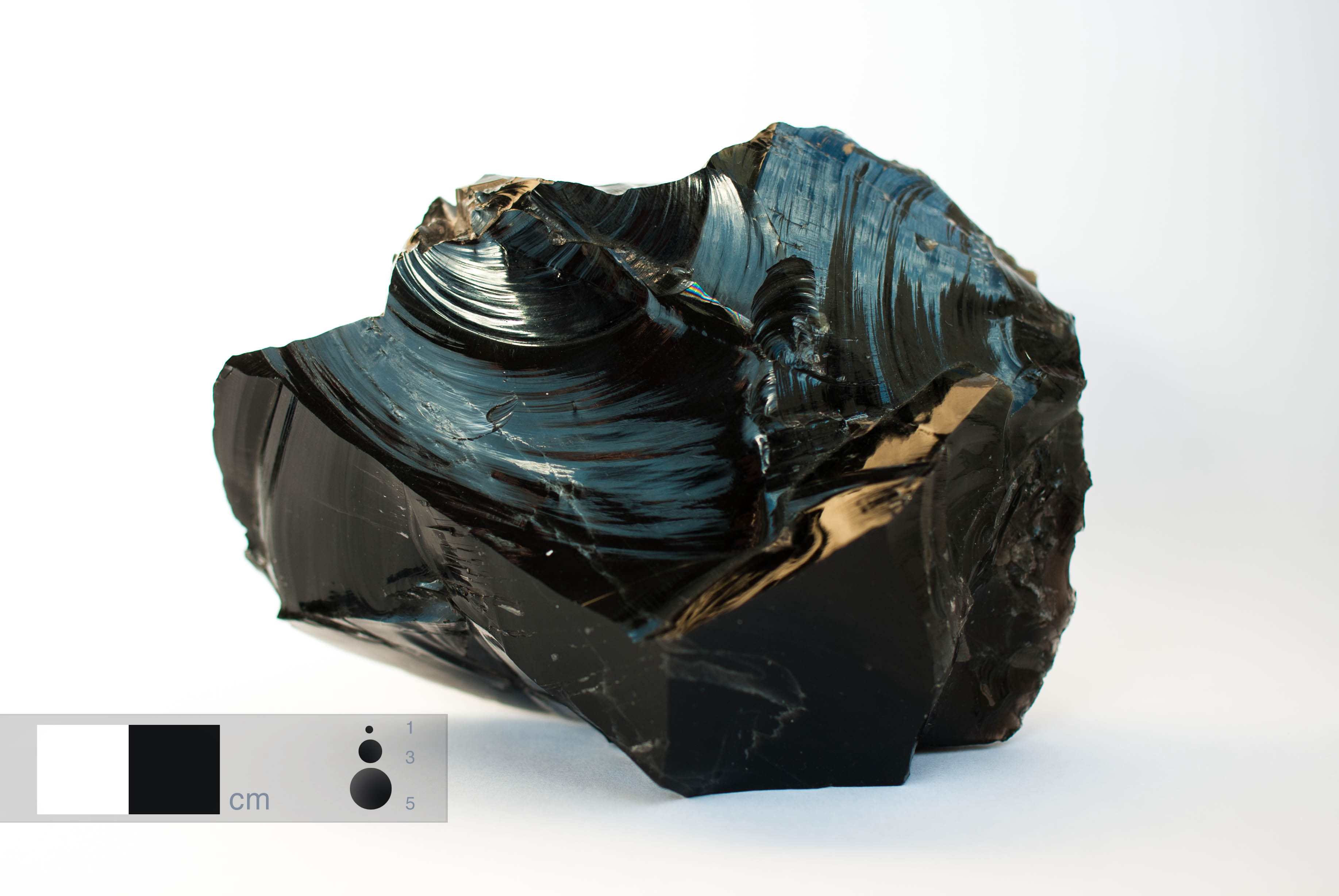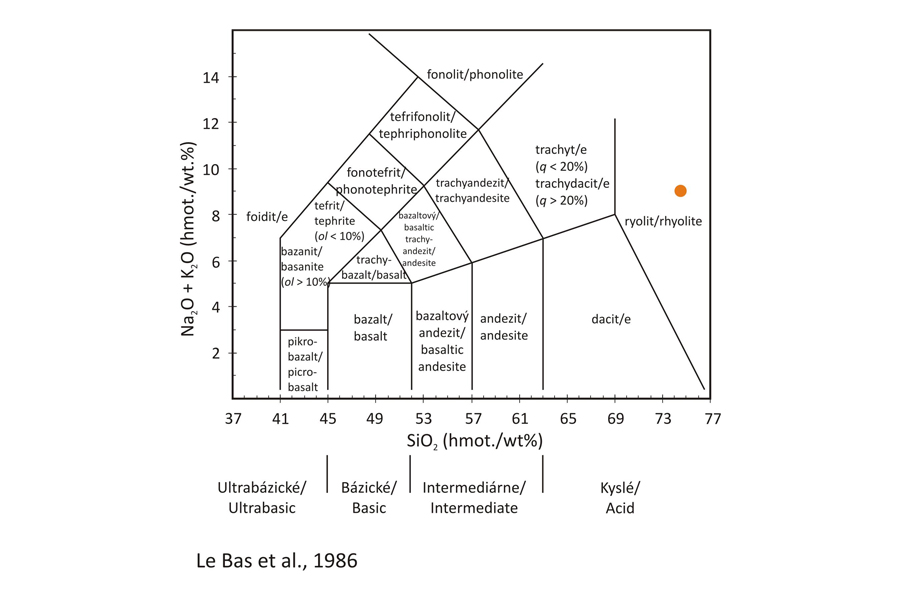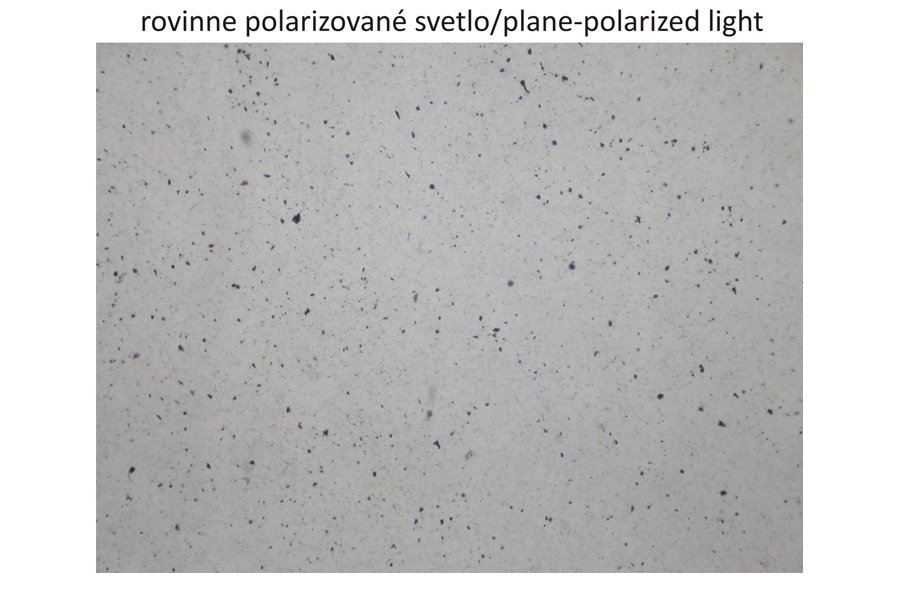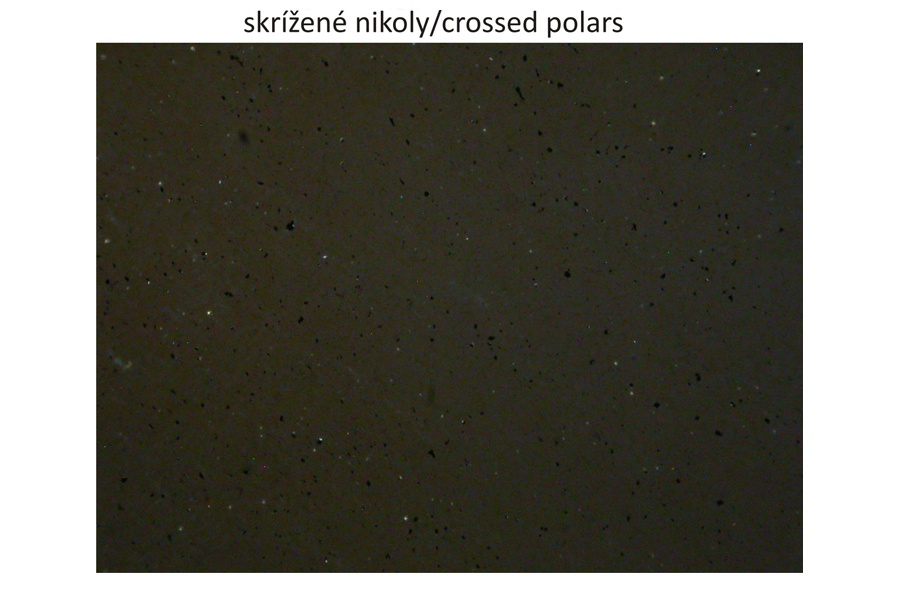Obsidian
Category: Volcanic glass
Type Volcanic glass.
Commons Obsidian is a volcanic rock, in which glass occupies more than 80 % of volume. Obsidians have a vitreous lustre and conchoidal fracture. Typical colours vary from dark, black, grey-black to grey, but red, brown-green, green, yellow and rare transparent colourless obsidians also occur. Colour is controlled by the trace element content and the character of inclusions. Combination of two colours in one hand-specimen is common. The combination of black and brown colours – the mahogany obsidian – is the most abundant. An obsidian with white, radially concentric flakes of cristobalite, named the flocullent obsidian, is the product of partial crystallization of a metastable glass. Obsidians can also rarely contain a larger amount of inclusions (small rock fragments, crystals, gas vesicles) which reflect the light and create a variegated play of lights. This kind of obsidian is designated as iridescent, silver, or golden according to the colour of the gloss. Extremely rare is a flaming obsidian, which is relatively clear, but glaring colours originate inside it as a result of the light reflection from very thin layers. Obsidian most frequently originates by a rapid coooling of a felsic viscous lava. Diffusion in the very viscous acid and felsic lavas with highly polymerized SiO2 tetrahedrons is slow, thus inhibiting the nucleation of crystals and supporting the origin of the glassy structure. Obsidian is fragile, tough and it disintegrates to very sharp slivers.
Name origin The name obsidian is very ancient. It is ascribed to Theophrastus who used it for the first time in 320 BC. The name origin is not fully elucidated. It also appears in the work of Pliny the Elder – the Natural History (77 – 79 AD) who mentions the volcanic glass called „obsian“ named after a similar stone from the Obsius locality of Ethiopia.
Locality Lipari, Aeolian Islands, Italy.
GPS: 38° 30' 36.34" N, 14° 57' 21.81" E
Major minerals Amorphous volcanic glass that exhibits the structural ordering similar to crystals only in very short distances. For this reason, the obsidian is sometimes regarded as a mineraloid.
Accessory minerals
Classification Volcanic rocks containing more than 80 vol. % of glass do not have their own classification, but they can be characterized using the TAS diagram in terms of their chemical composition. However, individual types of volcanic glasses also differ in terms of their structure and texture. The obsidian from the Lipari Island corresponds to the rhyolite glass.


Colour Black.
Structure Massive.
Granularity Glassy, aphanitic rock.
Texture Glassy (vitreous, hyaline).
Alterations Glass is neither altered nor devitrified.
Petrographic characteristics Unaltered compact obsidian with black colour, pronounced conchoidal fracture and sharp edges. It does not contain any macroscopically discernible inclusions of gases, liquids or solids, such as minerals or rock fragments. The obsidian exhibits a pronounced vitreous lustre. It does not scratch glass, thus corresponding to the hardness of 5 or 6 in the Mohs scale. It is translucent in thin cleavage fragments and along sharp margins.
Usage Obsidian has been used for the manufacturing of everyday working tools in prehistorical times. The oldest preserved findings come from Late Neolithic times as heads of arrows, spears, harpoons, knife blades, scrapers. Obsidian have been used during whole history of humankind, and recently it is utilized in surgery to make ultra-thin cuts. Obsidian has served in past and present as a decorative and jewellery stone.
Literature Ammerman, A. J. & Polglase, Ch., 1998: Obsidian at Neolithic sites in Northern Italy. Preistoria Alpina, Museo Tridentino di Scienze Naturali, 34, 291 – 296. Ma, Ch., Rossman, G. R. & Miller, J. A., 2007: The origin of color in „fire“ obsidian. The Canadian Mineralogist, 45, 551-557.
Photomicrographs


The volcanic glass is unaltered and it does not contain any quartz and/or feldspar crystallites that originate on a slower cooling. The obsidian is isotropic in crossed polars of the optical microscope. Width of photomicrographs corresponds to 2.2 mm.
Normative composition
Obsidan is the quartz-oversaturated volcanic rock with a lower content of normative anorthite – an compared to that in rhyolite and granite. It does not contain normative hypertshene – hy and corundum - c, in contrast with the rhyolite and granite. Wollastonite - wo in the norm results from a low MgO content, which produced a surplus calcium after creation of normative diopside – di. All Fe3+ was allocated in the normative hematite – hm.
Normative minerals
SiO2
TiO2
ZrO2
Al2O3
Fe2O3
FeO
MnO
MgO
CaO
Na2O
K2O
P2O5
F
S
CO2
Total
Molar proportion of normative mineral
Molecular mass of normative mineral
Weight % of normative mineral
Oxide
(wt. %)
74.51
0.08
12.75
1.63
0.00
0.05
0.03
0.72
4.03
5.13
0.06
98.99
Molecular
weight
60.08
79.88
101.96
159.69
71.85
70.94
40.31
56.08
61.98
94.20
141.95
Molecular
proportion
1.2402
0.0010
0.1250
0.0102
0.0007
0.0007
0.0007
0.0128
0.0650
0.0545
0.0004
ap
0.0014
0.0004
0.0004
328.68
0.14
il
0.0007
0.0007
0.0007
151.75
0.11
tn
0.0003
0.0003
0.0003
0.0003
196.07
0.06
or
0.3268
0.0545
0.0545
0.0545
556.67
30.32
ab
0.3901
0.0650
0.0650
0.0650
524.46
34.10
an
0.0111
0.0056
0.0056
0.0056
278.21
1.55
hm
0.0102
0.0102
159.69
1.63
zvyšky
0.0000
0.0007
0.0056
di
0.0015
0.0000
0.0007
0.0007
0.0007
216.56
0.16
wo
0.0048
0.0048
0.0048
116.17
0.56
q
0.5056
0.5056
60.08
30.37
D: -0.5056
Mg/(Mg+Fe2+): 1.000
Total of normative wt. % 98.99
Comment All iron in the chemical analysis is given as Fe3+. A small molar proportion of Fe2+ originated due to the addition of molar proportion of Mn to that of Fe2+. Hence, normative ilmenite – il was created from the Fe2+ and not from the Ti content, as it is common in other rocks. The residual Ti was then allocated in titanite – tn and the excess Fe3+ in hematite. However, the normative titanite can be created only with surplus Ca after creation of the normative anorthite - an. Diopside – di was created from a low amount of Mg. The surplus Ca after creation of apatite – ap, titanite – tn and anorthite – an was allocated in wollastonite – wo.
Chemical composition
Chemical composition of obsidian is close to that of rhyolite or granite, with dominant SiO2. MgO and Fe2O3 are the most common minor constituents, which affect the colour of obsidians. In contrast to common rhyolite and granite, the Al2O3 content is lower. As a rule, granite and rhyolite are peraluminous, with corundum in their norms, whereas the Lipari obsidian is metaluminous, devoid of the normative corundum. Some obsidians can be slightly peraluminous, for instance that from the Glass Buttes locality in U.S. The Fe2O3 content (wt. %) in the Lipari obsidian was recalculated to FeO for the purpose of the proper calculation of the Mg-number -Mg/(Mg+Fe2+). Obsidian is unstable in atmospheric conditions and it temporally crystallizes to very finely grained crystal aggregate. Weathering is accelerated in the presence of water. Obsidians from various localities in the World differ partly in terms of their trace element contents. This can be utilized for the provenance studies of historical artifacts. The Lipari obsidian contains 46.7-58.4 ppm La, 0.95-1.75 ppm Sc and 15.1-16.4 ppm Cs. The Cs content in the obsidian from the Palmarola Island, 1.13-1.56 ppm, is similar to that in the Lipari obsidian.
-
SiO2
74.51TiO2
0.08Al2O3
12.75Fe2O3
1.63MnO
0.05MgO
0.03CaO
0.72Na2O
4.03K2O
5.13P2O5
0.06Total
98.99Mg(Mg/Fe2+)
0.04A/CNK
0.95A/NK
1.05
-
SiO2
77.53TiO2
0.29Al2O3
12.39FeO
0.62MnO
0.02MgO
0.01CaO
0.72Na2O
3.31K2O
4.12Total
99.01Mg(Mg/Fe2+)
0.03A/CNK
1.10A/NK
1.25


